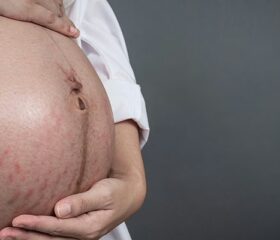Types of Diaper Rash and How to Treat and Prevent Them
Just hearing the words “diaper rash” can be enough to send shivers down a parent's spine.

Diaper rash is a common—and often frustrating—skin issue that affects babies. Rather than being caused by just one condition, there are several different types of diaper rashes. Let’s break down the various types, what causes them, and how to effectively treat them.
What is a diaper rash?
Simply put, a diaper rash is any irritation or redness in your baby’s diaper area, like his buttocks, thighs, and genitals. 1 Unfortunately, it’s a common complaint, with more than half of babies between 4 months old and 15 months old developing it at least once within a 2-month period. 2
What causes diaper rash?
Your baby may get a rash from too much moisture in her diaper area or prolonged exposure to urine or stool. 1
However, since there are various kinds of diaper rashes, other factors, such as allergies, infections, and even certain skin conditions like cradle cap and baby acne, can also play a role.
What are the signs of diaper rash?
The telltale signs of diaper rash include pink skin with or without bumps in milder cases, or (in severe cases) painful, red skin that may even bleed.
Depending on the type of diaper rash your baby has, her skin may be itchy or sensitive, making her restless and irritable. 3
What are the different types of diaper rash?
To understand how to treat your baby’s rash, you’ll need to determine which kind of diaper rash your baby might have. Normally, diaper rashes come from one of these culprits: 4 5 6 7
| Type of diaper rash | Appearance | Location | Causes | Severity | Treatment |
|---|---|---|---|---|---|
| Contact dermatitis | - Red shiny skin | - Buttocks - Genitals - Upper thighs |
- Contact with wet or soiled diapers - Diarrhea |
- Mild | - Barrier creams and ointments - Air drying - Good hygiene |
| Allergic dermatitis | - Raised red, weal-like lesions | - Area that had contact with the allergen | - Substances in diapers - Wipes - Diaper creams - Soaps - Detergents - Bath products |
- Requires visit to doctor | - Identifying allergen - Antihistamines and/or topical corticosteroids (prescribed by doctor) |
| Candida dermatitis (yeast infection) | - Deep red patches - Satellite lesions (small, red bumps scattered around the main rash) |
- Diaper area - Mouth (oral candidiasis) |
- Fungal infection (Candida albicans) - Untreated dermatitis |
- Requires swift medical attention | - Antifungal cream (prescribed by doctor) |
| Bacterial dermatitis | - Deep red or yellow crusting (which may weep, and may be raw in the case of strep) - In severe cases, pimples that ooze pus |
- Diaper area - Anus (strep infection) |
- Staphylococcus aureus (staph infection) - Streptococcus pyogenes (strep infection) - Can become serious if they aren’t treated |
- Requires swift medical attention | - Antibiotics (prescribed by doctor) |
| Intertrigo | - Symmetrical red or reddish-brown rash - Small bumps |
- Diaper area | - Skin-to-skin friction in a baby’s diaper area - Contact with pee or poop - Candida (secondary infections) |
- Requires visit to doctor | - Keep diaper area cool and dry - Antifungal cream (prescribed by your doctor for candida) |
| Eczema (atopic dermatitis) | - Dry, red (or darker than normal skin color) rash - Scaly and may be itchy |
- All over the body | - Genetic - Environmental factors |
- May require visit to doctor | - Loose, cotton clothing - Moisturizing cream or ointment - May require prescription medication |
| Psoriasis | - Thin, oyster-like scales in the diaper area - Can be itchy or painful |
- Diaper area | - Overreactive immune system | - Requires visit to doctor | - Moisturizers - Topical corticosteroids - Other topical medications - UV light (in severe cases) |
| Seborrheic diaper dermatitis | - Red skin sometimes with oily, yellow patches | - Diaper area - Scalp (cradle cap) - Face - Neck |
- Excess yeast on a baby’s skin | - May require visit to doctor (if present past 18 months) | - Gently washing with water - May require prescription medication |
| Heat rash (miliaria) | - Tiny, red bumps in the creases of the diaper area | - Creases of diaper area | - Overheating - Being overdressed |
- Mild | - Loose, breathable clothing - Cooler, less humid environments |
While this table can give you a general overview of the different types of diaper rash, you’re best off getting your baby checked out by your pediatrician.
Since certain types of diaper rash can be severe (e.g., bacterial or candida dermatitis), always ask your pediatrician if you’re unsure.
How can you treat a diaper rash?
Diaper rashes account for 25% of the cases where parents visit the doctor for a suspicious-looking skin condition during their baby’s first year. 8
Fortunately, you can manage most diaper rashes at home by focusing on: 9 10
- Hygiene: Change your baby’s diapers as soon as they’re wet or soiled, even if it means waking her up in the night. When you change her, gently clean the area with a soft cloth or cotton ball and warm water. Avoid harsh wipes containing alcohol, fragrances, or other irritants. For severe rashes, use a squirt bottle with warm water so you don’t need to rub her skin.
- Diapers: Opt for diapers that fit well and are highly absorbent. If your baby is sensitive to certain brands or materials, choose diapers made from hypoallergenic materials or fragrance-free ones.
- Air drying: Your baby’s skin may just need to breathe. Let the diaper area air dry completely before applying any creams or ointments. Gently pat the area dry with a soft towel instead of rubbing it. When possible, let her go without a diaper for short periods so her skin can air out. Put a towel underneath her to protect surfaces from accidents.
- Barrier creams and ointments: You can apply barrier cream or ointment with each diaper change, even when there’s no rash. Choose products containing zinc oxide or petrolatum (like Vaseline or Aquaphor). Apply a thick layer, and be careful not to remove it when you change her diaper. Simply blot away any pee or stool and reapply.
- Diet: As mentioned, introducing your baby to new solid foods can affect her poop, leading to irritation when it touches her skin. Citrusy foods and juices can make her stool acidic and make her dermatitis worse. Avoid spaghetti sauce, soup, oranges, strawberries, lemons, and berries.
Before treating your baby’s diaper rash (especially if you plan on using barrier creams or ointments), always ask your pediatrician first.
It’s also a good idea to track how your baby’s skin changes with notes and pictures in your gallery or baby tracker app so that you can give your pediatrician an accurate report of the the condition’s progression (or lack thereof).
Take special hygiene precautions with cloth diapers
If you’re using cloth diapers, wash them with gentle, fragrance-free detergents and skip fabric softeners or dryer sheets, as they can irritate your baby’s skin. 11 Change cloth diapers frequently and consider using diaper liners.
When should you see a doctor?
While most diaper rashes resolve with home treatment, you should seek medical attention if your baby’s rash: 12 13
- Becomes severe (with open sores, blisters, or pus-filled bumps)
- Doesn’t improve after a few days of home treatment
- Spreads beyond her diaper area
- Is accompanied by a fever over 100.4 °F
If your baby has a yeast infection, your pediatrician may prescribe an antifungal treatment, such as clotrimazole or nystatin cream.
As for bacterial infections, she may need a prescription of topical or oral medication.
Separately, she may be prescribed steroid creams for eczema or psoriasis.
Use any medicated creams or ointments as directed by your pediatrician. To reiterate, always check in with them if you’re unsure about the cause or type of rash you’re dealing with.
Article Sources
- Cleveland Clinic. "Diaper Rash (Diaper Dermatitis)" Retrieved November 14, 2025.
- The American Academy of Pediatrics. "Diaper Rash - Guidelines for Parents" Retrieved November 14, 2025.
- Seattle Children’s Hospital. "Diaper Rash" Retrieved November 14, 2025.
- Johns Hopkins Medicine. "Diaper Dermatitis" Retrieved November 14, 2025.
- Cleveland Clinic. "Intertrigo" Retrieved November 14, 2025.
- Mount Sinai. "Rash - child under 2 years" Retrieved November 14, 2025.
- Johns Hopkins Medicine. "When Psoriasis Afflicts Children" Retrieved November 14, 2025.
- StatPearls. "Diaper Dermatitis" Retrieved November 14, 2025.
- Texas Children's Hospital. "PCP Referral Guidelines- Diaper Dermatitis" Retrieved November 14, 2025.
- Nationwide Children’s Hospital. "Thrush and Yeast Infections" Retrieved November 14, 2025.
- Children's Health Network. "Laundering Your Baby's Clothes" Retrieved November 14, 2025.
- The Society for Pediatric Dermatology. "What is diaper rash?" Retrieved November 14, 2025.
- Children’s Hospital Los Angeles. "How to Heal Your Baby’s Diaper Rash" Retrieved November 14, 2025.






